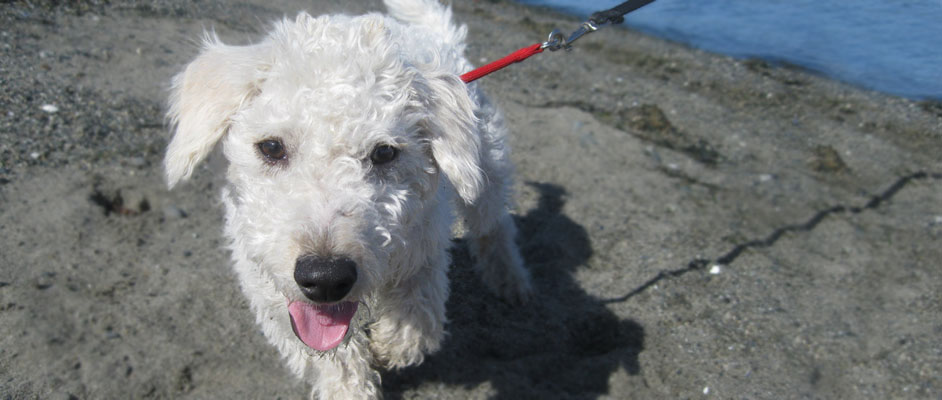
The Why, When & How of saying no to our dogs.
This is my first posting on the new Victoria Adoptables website (congratulations Carol and Adam on a beautiful job of redesigning and build the site.) and I would like to say a sincere thank you to Carol for the opportunity to share my thoughts and experiences from my many years of helping animals and their guardians.
This is the first of a three part entry. The Why, When and How of Canine Discipline.
Likely the most discussed and disagreed upon subject in guiding and teaching our canine companions.
It’s one of those facets of dog behaviour about which it’s said; the only thing two trainers might agree upon is that the third trainer is doing it wrong.
A significant percentage of behavioural issues I am called upon to resolve are based on discipline that has been applied with aggression/force, inconsistently or the more common… little or none at all. Many people have an instinctive dislike for the thought of “dominating” their dog and with no other tools offered, apply little if any discipline.
It’s unfortunate that too many dog owners easily fall into the role of aggressively dominating their dog.
Whether working with killer whales or rabbits I have always been a “positive” based teacher. These are my particular thoughts, at this time, as to Why, limit setting discipline communications can be beneficial to our relationship with our dogs.
Human-animal relationships are a complicated social interweaving, especially with our dogs. We spend a lot of time together. Since it’s possible that we are the more intelligent of the two species, the responsibility is ours to build clear communications. We need to be the teacher.
By teaching our dog that when they see us looking at them and they hear their name and a calmly delivered… “No” or “Uh Uh”, it simply means that; “This is something I shouldn’t be doing or touching.” It is a “limit setting” communication if taught calmly and with consistent certainty. It will become a “punishment” communication if the lesson is taught with aggression. If our dog rushes forward to grab that chocolate bar that just hit the ground and we are able to calmly say; “Rover… no.” and then redirect their focus, you will have avoided using punishment.
Granted, using aggressive punishment can yield quicker results because the dog was fearful but at what cost? If you drop the chocolate bar, your dog rushes forward and you angrily yell… NO!! and grab them by the scruff; sure you’ve protected them from eating chocolate and getting sick but how will they react to your touch when you go to pet them a few minutes later
There are relationship benefits to being able to set limits and tell our dogs no… but we also need to do so in a canine familiar style and structure. This does not include swatting with a newspaper, squirting lemon juice in their face or “pinning” the dog to the ground. If we discipline our dogs too aggressively they will fear, not respect us. People who rely on dominance theory to train their pets may need to regularly threaten them with aggressive displays or repeatedly use physical force. Conversely, dogs subjected to threats or force may not offer submissive behaviour, instead, they may react with aggression, not because they are trying to be dominant but because the human threatening them makes them afraid; they are simply protecting themselves.
Dogs are no different than any other social species on our planet in that they benefit from an understanding of the limitations and boundaries of their social environment. If someone is not there to set those limits and teach them as to where the boundaries lay the consequences could be grievous.
The Dominance Theory effect.
For decades dog trainers have relied upon the theory of social dominance behaviour in Wolves as the cornerstone of training and managing dog behaviour. We were taught that we must be tough disciplinarians with our dogs otherwise they will run amuck.
I heard of one trainer who taught his/her students that all dogs are potentially aggressive and yearn to dominate you. If a dog was stubborn and disobedient it was necessary to badger the dog until they became aggressive in order to physically exert dominance and have the dog understand who the “Alpha”, in the pack is.
This treatment is not the behaviour of a “pack” leader. This is the behaviour of a malevolent dictator.
Dominance and leadership are not synonymous.
Leadership should be attained by more positive means—by rewarding appropriate behaviours and using desired resources such as food, toys or affection as reinforcement for these behaviours. Leadership is established when a dog owner can consistently set clear limits for behaviour and effectively communicate the rules by immediately rewarding the correct behaviours and preventing access to or removing the rewards for undesirable behaviours before these undesirable behaviours are reinforced. Dog owners must avoid reinforcing undesirable behaviours and only reinforce the desirable behaviours frequently enough and consistently enough for the good behaviours to become a habit.
With so much focus on dominance and discipline we spend more time saying No and not near enough time guiding our dogs by teaching them what it is we desire from them.
More recent research on Wolf social behaviour indicates that there is indeed a pack leader but rather than a hard as nails General in charge of the troops; the leader is more like a patriarch/matriarch and the pack is akin to a family unit. There is dominant and submissive behaviour within the pack members but the expressions of the behaviour are subtle.
We do need to say No to our dogs but we need to do so with patience and persistence rather than using force and coercion.
“Because fear and anxiety are common causes of aggression and other behavior problems, including those that mimic resource guarding, the use of punishment can directly exacerbate the problem by increasing the animal’s fear or anxiety. Overall, the use of dominance theory to understand human-animal interactions leads to an antagonistic relationship between owners and their pets.”
(American Veterinary Society of Animal Behavior - 2007.)
Because each dog has a different personality and the circumstances and motivation for the undesirable behaviour differ; the use of discipline and the form it takes needs to be carefully considered. Puppies need to be treated much differently that adolescents or adults. Some dogs are very sensitive others are very confident and self-minded.
Usually, a calm discipline communication followed by “redirecting” the dogs focus is the most effective technique. In other cases it might be more effective to deliver the discipline communication and simply stand your ground until the dog learns that you are firm in your resolve.
Each and every dog is a unique individual with varied learning needs. The style and structure of your communications need to match your dog’s ability to learn. If we find that we are spending more time delivering discipline than praising; it’s time to step back, think about what’s going on and take a different approach.
At my next posting I’d like to talk about the WHEN of saying no to our dogs.
If you have comments or questions, please address them to: [email protected]


